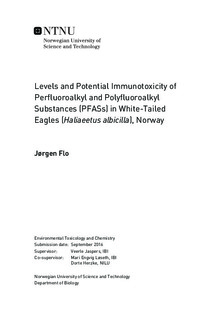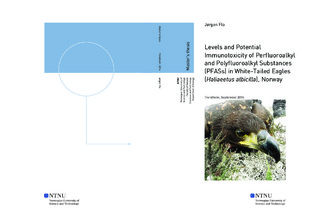| dc.description.abstract | The white-tailed eagle (WTE) is exposed to a wide range of contaminants due to its high trophic position in the marine ecosystem. Perfluoroalkyl and polyfluoroalkyl substances (PFASs) are persistent and bioaccumulative chemicals, which recently have been shown to exceed concentrations of other persistent organic pollutants (POPs) in WTE nestlings. Experimental studies suggest that immunomodulation by PFASs occurs at environmentally relevant levels, presenting the need for additional studies to determine if such effects are present in avian wildlife. The first aim of the current study was to investigate the levels of PFASs in plasma and feathers of WTE nestlings, assessing variation relating to differences in sampling location and biological variables. The second aim was to investigate the relationship between PFASs and two structural indicators of the immune system: leukocyte counts and protein fractions. Two WTE populations were sampled: Steigen (n = 14, nests = 9) and Smøla (n = 13, nests = 10).
Linear nested models showed that levels of Σ7PFASs in plasma were significantly increasing with age (p < 0.01) and body mass (p < 0.01) in both populations, while suggesting a higher dietary accumulation in nestlings from Steigen (p < 0.01). The levels and detection frequency of PFASs was lower in feathers compared to plasma, and a clear connection between the two matrices could not be established. The current study emphasises the importance of variation explained by variables as age, mass, sex and sampling location when assessing environmental exposure to PFASs.
No associations were found between PFASs and protein fractions or leukocyte percentages. The prealbumin (p = 0.004) and γ globulin (p = 0.054) concentrations differed between populations, and prealbumin levels were positively associated with mass (p < 0.01). WTE nestlings had high leukocyte percentages of heterophils (48 %), lymphocytes (31 %) and eosinophils (16 %), comparable with those of healthy bald eagles (Haliaeetus leucocephalus). Assessment of protein electrophoretic patterns and leukocyte percentages both suggested that all the nestlings in the current study were healthy. However, the sensitivity and ability of the two biomarkers to detect potentially small immunological effects of contaminants in wildlife may be insufficient. Protein electrophoresis showed to be the most promising biomarker in the current study, and further advances may aid sensitivity and identification of specific proteins. | |

